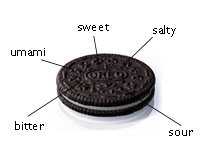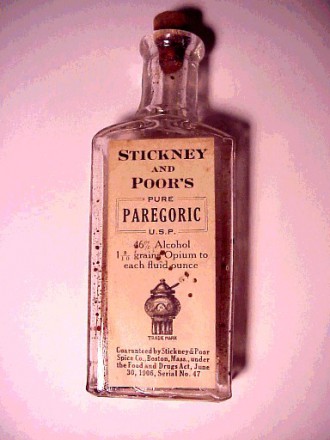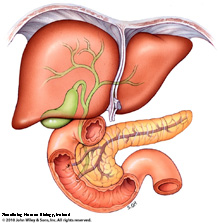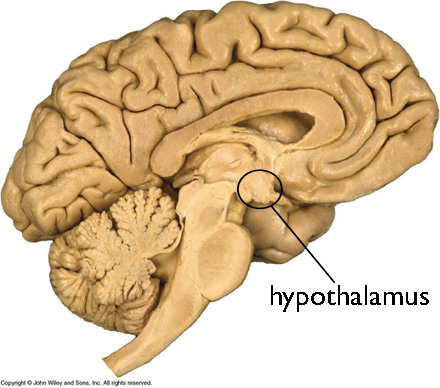Each Sunday, I’m excerpting a chapter of The Seven Deadly Synapses, a book on the neuroscience of sin. In this series, we’re examining the sin of Gluttony.
In part 1 of “Gluttony”, we didn’t get to the scientific part. It was mostly just a warm-up. Now it’s time to figure out how the taste system sends a signal to the brain, and how the digestive system handles food.
Gluttony
Part 2
For most of mankind’s history, eating has been the key to staying alive and so has been a human’s main job. Most of a person’s waking hours were devoted to getting calories, processing calories into a healthy and digestible form, and storing calories for future needs. The word “famine” appears 107 times in the King James Version of the Christian Bible (including the passage shown here, that describes a famine so severe that a mother boils and eats her son); “hunger” 60 times; “starve”, “starving”, “starvation”, 19 times. Other religious texts show a similar historical fixation with either metaphorical or real hunger: the word is used 74 times in the Qur’an, and only 18 times in the Upanishads. Gluttony is likely to be a sin mostly because it revels in the flaunting of what mankind has struggled so hard, for so many years, to achieve: nutrition.

To find food, and eat it, and to balance surfeit with famine, is the responsibility of a few thousand nerve cells in a pinky-end-sized hunk of brain called the hypothalamus. Just like the thermostat in your house keeps the household temperature close to where you want it to be, the hypothalamus is responsible for your body’s balancing acts, the processes and feedback loops that physiologists call “homeostatic mechanisms”. Like Goldilocks, we want our bodies to be “just right”. not too cold, not too hot; not too thin, not too fat; not too much breath, not too little. How the hypothalamus causes us mischief is the root of our story.
The path that food takes is complicated enough. After dipping your Oreo in a glass of milk, you chew and swallow it. Your taste buds analyze the five primary taste qualities in the cookie: sweet, salty, umami (“savory”, the flavor of sushi), bitter and sour. Each of these has a canonical, standard chemical: sweet is sucrose (table sugar); salty is sodium chloride (table salt); umami is monosodium glutamate (glutamate is an amino acid, one of the building blocks of protein); bitter is quinine (as in tonic water) and sour is acid (hydrogen ions). An Oreo cookie is strong in sweet and salty, with a trace of umami, and won’t have any bitter or sour qualities. (Unless the milk has turned.) There are enzymes in the saliva and on the tongue which begin the breakdown process. One of these, lingual lipase, gives us a pleasant silky coating on the tongue as it breaks down fats. Another, salivary amylase, breaks down complex starches into simple sugars. It’s why potatoes taste sweet.
 The analysis of an Oreo, broken into its five parts, is sent to the brain, which decides the Oreo is indeed quite tasty, and allows it to be swallowed. If the brain detects flavors that might indicate harmful toxins or spoilage, it sends an emergency signal to the nerves that control the gag reflex: spit it out.
The analysis of an Oreo, broken into its five parts, is sent to the brain, which decides the Oreo is indeed quite tasty, and allows it to be swallowed. If the brain detects flavors that might indicate harmful toxins or spoilage, it sends an emergency signal to the nerves that control the gag reflex: spit it out.
The taste of a cookie is a conscious sensation, routed through the “executive secretary” of the brain, the thalamus. Taste sensations, carried on three nerves, are relayed through the thalamus up to the crinkly outer covering of the brain, the cortex. Anything that reaches cortex is a sensation we’re aware of. Any movement initiated by nerve cells in the cortex is something we can modify and control. The muscle movements that control chewing and swallowing are also voluntary; they are under your conscious control, with a signal starting in the cortex near the front of your brain, about two inches forward of your ears, and relayed through the thalamus down to the lower centers that contain the nerve cells which directly cause muscle contraction.
 The chewing muscles are controlled by outgoing signals that are carried on the same nerve as you use to feel pain in your face and teeth, the same nerves that jangle when you eat an habenero pepper or ask for your Thai food “extra spicy”. Another nerve takes over the voluntary act of swallowing for the back of your mouth as the food slips down your throat. The epiglottis, a “sorting paddle”, decides that food is to go down your esophagus, a muscular tube, instead of the trachea, the breathing pipe that runs parallel with it. At about this same point, a set of little brains (knots of nerve cells, or neurons) that run along the esophagus began to fire in a characteristic pattern, squeezing a spot on the gut tube and then moving the squeezed spot towards the end, “milking” the food from the top of your throat down past your diaphragm and into your stomach. These muscles, and everything past them until the very end of your digestive tract, are all outside of your voluntary control. This milking mechanism is called peristalsis. Opium-like drugs slow this process down, which is why they cause constipation (or stop diarrhea, if that’s what you want). Many kinds of laxatives stimulate this process, which moves food along faster.
The chewing muscles are controlled by outgoing signals that are carried on the same nerve as you use to feel pain in your face and teeth, the same nerves that jangle when you eat an habenero pepper or ask for your Thai food “extra spicy”. Another nerve takes over the voluntary act of swallowing for the back of your mouth as the food slips down your throat. The epiglottis, a “sorting paddle”, decides that food is to go down your esophagus, a muscular tube, instead of the trachea, the breathing pipe that runs parallel with it. At about this same point, a set of little brains (knots of nerve cells, or neurons) that run along the esophagus began to fire in a characteristic pattern, squeezing a spot on the gut tube and then moving the squeezed spot towards the end, “milking” the food from the top of your throat down past your diaphragm and into your stomach. These muscles, and everything past them until the very end of your digestive tract, are all outside of your voluntary control. This milking mechanism is called peristalsis. Opium-like drugs slow this process down, which is why they cause constipation (or stop diarrhea, if that’s what you want). Many kinds of laxatives stimulate this process, which moves food along faster.
The milk-sodden Oreo, broken into little pieces by the action of your teeth and tongue, is squeezed down the esophagus and into the stomach. The stomach senses the presence of food and begins to ramp up acid secretion. Mucus in the stomach protects it from attack by the acid it makes. Acids will break down the food, but have the secondary role of protecting us from any bacterial invaders that hitchhiked a ride along with the Oreo. The stomach has peristaltic waves of its own, again controlled by an autonomous little gut-brain, and it makes quick work of the Oreo.
 Now an acidic runny paste, the sludge travels from the stomach to the duodenum (the name means “12”, and it’s that many finger-breadths in length, by tradition). The duodenum is the first segment of the small intestine. Here, two more digestive organs add in their products. The helpful pancreas squirts out a bit of baking soda to neutralize the acid in the paste so it won’t damage the unprotected intestine. (The rest of the digestive tract isn’t protected from acid by a mucus layer like the stomach is.)
Now an acidic runny paste, the sludge travels from the stomach to the duodenum (the name means “12”, and it’s that many finger-breadths in length, by tradition). The duodenum is the first segment of the small intestine. Here, two more digestive organs add in their products. The helpful pancreas squirts out a bit of baking soda to neutralize the acid in the paste so it won’t damage the unprotected intestine. (The rest of the digestive tract isn’t protected from acid by a mucus layer like the stomach is.)
All foods are made up of only three kinds of molecules: carbohydrates (sugars), lipids (fats), and protein. The Oreo filling is fat and sugar creamed together. The cookie part is a bit of wheat protein, a bit of fat, and a bit of sugar.
Of the three, the fat component is handled first. Day and night, the liver makes a greenish-brown liquid, called bile, which is stored in the gall bladder. Special molecular messengers signal the presence of fat in the Oreo filling. The gall bladder and pancreas share a nozzle. Along with the pancreatic baking soda to neutralize acid, and pancreatic enzymes to break down proteins, the gall bladder squirts a little bit of its fat-dissolving liquid into the duodenum. The bile helps break fats into little bubbles that can be easily absorbed by the digestive tract.
As your Oreo, now mostly molecules, travels down the 20-odd feet of small intestine, the gooey liquid is roiled, tumbled, mixed by the shag carpet-like covering inside the intestines. The other function of this carpeting is to increase the number of cells that are exposed to the molecules in the Oreo.
The cells that line the intestine are looking for sugar molecules. Sucrose, or table sugar, is made up of two smaller sugar molecules linked together: glucose (also called “dextrose”), and fructose (also called “fruit sugar”). Each cell lining the intestine has a cadre of worker molecules that watch the food traveling down the digestive tract and when they spot a glucose or fructose molecule, like a grizzly grabbing a salmon from a cold stream, they seize that molecule and bring it inside the cell. There, it’s passed along to the bloodstream.
The worker molecules which capture nutrients with their molecular bear paws also grab some toxic substances and drugs. The entire bloodstream draining from the stomach and intestines is collected and filtered through an organ called the liver, the second-largest organ in the human body (tied with the brain for size and weight, but smaller than the skin). The liver has three main functions: it produces bile for digesting fats; it filters and cleanses the blood draining from the intestine; and it serves as a protein factory to make essential protein molecules the body needs. We looked at the way bile helps absorb fats, and we won’t think much about the liver as a protein factory. What about the liver as a detox organ?
One drug that is captured by the intestinal cells is grain alcohol, ethanol. It passes into the bloodstream, and the liver is the first organ to encounter alcohol in the blood. The liver’s job is to deactivate the alcohol before it can have an effect on the other organs of the body. This extra load is what causes death of liver cells from overwork, a disease we know as cirrhosis of the liver.
We can safely assume that the Oreo doesn’t have anything toxic clinging to it, so the blood doesn’t need detoxification. Blood, now full of nutrients and cleansed by the liver, is passed to the heart so it can be pumped around the body. There, the hungry cells in dozens of organs use the glucose molecules carried to them by the intestine-enriched, liver-detoxified, heart-pumped blood.
The parts of the Oreo you can’t use are expelled from the large intestine. The involuntary process of peristalsis comes to an end, literally, at the anus. There, autonomic control ends, and voluntary control is given back to the brain’s cortex. The cortex controls a ring of muscle that prevents embarrassment by staying tightly closed until we find our way to the lavatory to expel our waste in a socially acceptable way. The crinkly cortex tells the anal sphincter that we’re firmly planted on a toilet seat, and commands the sphincter to relax and expel solid waste.
Next Sunday, May 1: Part 3 of Gluttony
